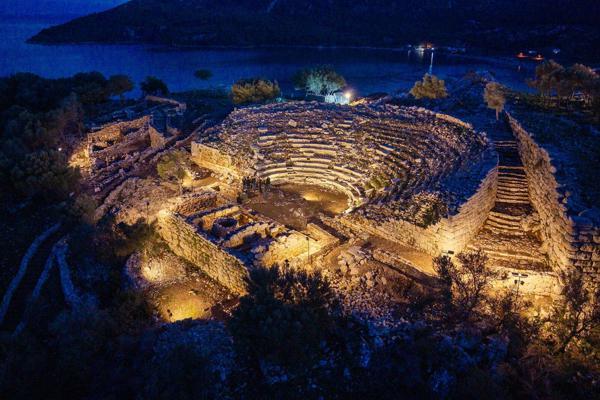Lighting work completed in Amos
MUĞLA


The lighting installation in the ancient city of Amos in Muğla's Marmaris district has been completed.
Located 20 kilometers southwest of Marmaris on Asarcık Hill, the ancient city saw the conclusion of its 2024 works under the leadership of Associate Professor Mehmet Gürbüzer from Muğla Sıtkı Koçman University’s Faculty of Arts, Archaeology Department, as part of the Legacy for the Future project. Work for 2025 is scheduled to begin in February.
Excavations, which were granted Presidential Decree status in 2022 and are supported under the Culture and Tourism Ministry’s Legacy for the Future project, will continue with sponsorship from the Marmaris Chamber of Commerce (MTO), the Marmaris Municipality and Martı Hotel and Marina.
As part of the MTO’s sponsorship, 50 solar LED floodlights were installed in the ancient city under the supervision of archaeologists, following the implementation of security cameras and camera traps.
MTO President Mutlu Ayhan stated that they wanted to leave a lasting legacy for Marmaris in honor of the chamber's 30th anniversary.
Explaining that security has been enhanced with cameras and traps, Ayhan said: “We hope the city will be granted archaeological site status. Amos, which is drawing an increasing number of visitors each year, leads the way in establishing cultural tourism in Marmaris. We will continue working to make it suitable for nighttime museum visits in the future. From now on, the 3,000-year-old Amos ancient city will welcome boats entering Marmaris Bay in the evening with its lights.”
Excavation president Associate Professor Mehmet Gürbüzer noted that after the security and lighting improvements, the city will now also be accessible at night.
Surface surveys began in 2019 at the ancient city. Excavations conducted under the Culture and Tourism Ministry’s Legacy for the Future project have uncovered a necropolis area, Athena Temple, a public cistern, parts of an ancient road and staircase, sections of residential buildings, and the stage building of a theater. A section believed to have served as a thermopolium (a type of restaurant) and a storage area during the ancient period was also discovered.
